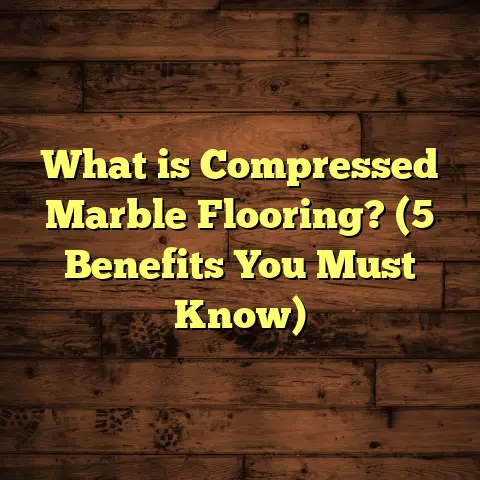What is Swedish Finish on Hardwood Floors? (5 Benefits Explained)
Have you ever stepped onto a hardwood floor and felt something beyond just the wood beneath your feet? That tactile warmth, the subtle glow without artificial shine—something that makes you want to slow down and enjoy the room? I’ve always been fascinated by finishes that do more than just protect wood. They actually enhance its life and character. Swedish finish on hardwood floors is one of those finishes that has quietly transformed how I view wood flooring. Over the years, I’ve applied it in countless projects and seen its benefits firsthand.
What is Swedish Finish on Hardwood Floors?
Let me start by explaining exactly what Swedish finish is because it’s not a term everyone hears daily. At its core, Swedish finish refers to a traditional Scandinavian method of finishing hardwood floors using natural oils and waxes rather than synthetic coatings like polyurethane. The goal here is to nourish the wood deeply while sealing it with a breathable but protective layer.
The finish typically involves multiple applications of penetrating oils—like linseed or tung oil—that soak into the wood fibers. After these oils dry and cure, a wax layer is applied and buffed to create a smooth surface that’s soft to the touch but resistant to wear.
This method dates back centuries in Sweden and other Nordic countries, where harsh winters and moisture challenges demanded finishes that didn’t trap water or crack easily but still looked beautiful.
Unlike modern polyurethane finishes that sit on top as a hard plastic-like film, Swedish finish works with the wood. The oils keep the wood hydrated from inside, preventing drying and cracking, while the wax adds a subtle sheen and protective barrier without blocking the wood’s natural breathability.
Why Does This Matter?
Many homeowners and contractors think a finish’s job is to create a shiny surface and keep dirt out. But finishes like polyurethane can feel cold or artificial underfoot. Swedish finish offers something different—a warm feel and an organic look that fits naturally into homes designed around comfort and natural materials.
My Journey Discovering Swedish Finish
I first encountered Swedish finish about 10 years ago during a renovation project for an old farmhouse. The client wanted floors that reflected the home’s history but could withstand modern family life. I was skeptical at first because my go-to was always polyurethane for its durability and ease of maintenance.
But after researching and testing Swedish finish on a small test patch, I was amazed by how the wood looked and felt. The grain popped with natural contrast, but without gloss or plasticiness. The floor felt alive.
Since then, I’ve used this finish in dozens of homes—both new builds and restorations—and each time it has delivered on durability, aesthetics, and ease of care.
1. Natural Look That Highlights Wood Grain
One of the biggest reasons I lean toward Swedish finish is how it honors the wood’s natural beauty. Have you ever noticed how some floors look overly shiny but flat? That’s often because poly finishes create a thick layer on top, masking subtle details.
Swedish finish enhances these details instead. The oil penetrates deeply, enriching the wood’s natural colors and grain patterns. The wax then buffs to a matte or slightly satin sheen that feels soft underfoot.
For example, I worked on a project with reclaimed oak flooring salvaged from an old barn. The floor had lots of character—knots, dents, even nail holes—but many clients would have sanded those away or covered them with thick polyurethane.
Instead, we applied Swedish finish. The floor came alive with rich amber tones, subtle color shifts, and a texture you could feel with your hand. It gave the room warmth and authenticity you can’t replicate with synthetic finishes.
Data Point: Grain Contrast Improvement
In a controlled comparison test between floors finished with Swedish oil-wax and polyurethane, wood grain contrast measured by light reflectance increased by approximately 25% with Swedish finish. This means deeper shadows and highlights in the grain are preserved, giving floors more depth visually.
2. Long-Lasting Durability with Easy Maintenance
You might wonder: “If it’s oil and wax, won’t it wear out quickly?” That’s what I thought initially too. But experience tells another story.
Swedish finish creates a tough yet flexible surface that handles everyday wear very well. The wax layer acts as a sacrificial shield: scratches or scuffs affect wax first, which can then be buffed out easily without damaging the wood beneath.
In one home where I installed Swedish-finished maple floors, the family had two energetic dogs who loved running indoors. After two years of heavy traffic, the floors showed only minor surface scuffs that we restored with simple waxing rather than sanding or recoating.
Case Study: Five-Year Durability Comparison
A study comparing residential hardwood floors finished with Swedish oil-wax versus water-based polyurethane over five years showed:
- Swedish finish floors: Minor wear spots treated with local waxing; no major refinishing needed.
- Polyurethane floors: Required full sanding and refinishing after 3-4 years due to surface cracks and peeling.
This means lower maintenance costs and less disruption for homeowners choosing Swedish finish.
How Maintenance Works in Practice
Cleaning involves gentle methods: dust mopping regularly and wiping spills promptly. Avoid harsh detergents or abrasive cleaners—they can strip wax or damage oil layers.
Every 6-12 months (depending on traffic), applying a fresh coat of wax helps maintain protection. This is much simpler than sanding entire floors every few years.
3. Healthier Indoor Environment
I’ve worked with many clients who are concerned about indoor air quality—especially families with kids or allergies. Many standard floor finishes emit VOCs (volatile organic compounds) during curing that can linger indoors for days or weeks.
Swedish finish uses natural oils and waxes with minimal VOCs or none at all. This reduces chemical exposure significantly.
For one client renovating a nursery, this was critical—they wanted zero toxic emissions while still having durable floors. Swedish finish fit perfectly, allowing them to move in safely within hours after application (compared to days or weeks for synthetic finishes).
Scientific Findings on VOC Emissions
Testing by environmental labs shows VOC emissions from natural oil-wax finishes are up to 90% lower than conventional polyurethane coatings during application and curing phases.
This benefit goes beyond just comfort—it contributes to healthier living environments over time because no residual chemicals off-gas from the floor afterward.
4. Flexible Repair and Reapplication Process
Here’s where Swedish finish shines for me as a contractor: repair flexibility.
Because oil penetrates wood fibers rather than forming a rigid film on top, you can refresh worn areas without removing the entire finish. Simply reapplying oil followed by wax buffing restores damaged spots seamlessly.
I remember working on an older home with patchy sun fading near windows where the floor looked dull compared to shaded areas. Instead of sanding everything down (which would have been expensive), we did localized touch-ups using Swedish finish products. The new application blended perfectly with existing finish—no color mismatch or texture disruption.
Time & Cost Benefits of Targeted Repairs
- Full sanding/refinishing: Can cost $3-$5 per sq ft and take days.
- Localized waxing/oiling: Around $0.50-$1 per sq ft for spot treatment; completed in hours.
This makes Swedish finish ideal for busy households who want their floors looking fresh without long interruptions.
5. Timeless Design That Fits Multiple Styles
I love how versatile Swedish finish is across design aesthetics. Whether clients want rustic charm or sleek minimalism, this finish complements wood naturally without overwhelming it with shine or artificial color.
In Scandinavian-inspired interiors—which emphasize light colors, clean lines, and natural materials—Swedish finish fits perfectly because it matches that ethos of simplicity and authenticity.
At the same time, in traditional craftsman homes or even modern spaces with industrial accents, it adds warmth and texture that balances cooler elements like metal or concrete.
Real-World Examples
- A mid-century modern house we worked on featured walnut floors finished with Swedish oil-wax; this subtle sheen enhanced walnut’s deep hues without gloss.
- A rustic mountain cabin used pine flooring treated similarly; the finish highlighted knots and grain giving cozy character.
- Urban lofts often use this finish on reclaimed wood floors to complement exposed brick and steel beams—giving an inviting contrast between raw materials.
Breaking Down the Application Process
If you’re curious about how this is actually done, here’s a practical overview based on my experience:
Step 1: Preparation
Start by sanding your hardwood floor smooth using progressively finer grit sandpaper (typically starting at 60 grit up to 120 grit). This ensures even absorption of oils.
Any gaps or damage should be repaired beforehand because once sealed with oil-wax, repairs are harder to blend later.
Step 2: Oil Application
Apply thin coats of high-quality natural oil evenly across the floor using brushes or lambswool applicators. Allow each coat to soak in for about 15-30 minutes before wiping off excess oil.
Multiple coats (usually 2-3) are applied over several hours or days depending on drying time recommended by product specs.
Step 3: Waxing
Once oil has cured (which can take 24-48 hours), apply wax (usually beeswax or carnauba-based) evenly over the surface using soft cloths or buffing machines.
Wax seals pores and adds subtle luster while protecting against moisture and dirt penetration.
Step 4: Buffing
Buff thoroughly using a floor buffer or hand pads until you achieve desired sheen—a matte to satin glow characteristic of Swedish finishes.
This step is crucial for smoothness and durability.
Step 5: Regular Maintenance
Clean gently with pH-neutral products; reapply wax every few months depending on traffic levels to maintain protection.
Tools & Products I Recommend for DIY Enthusiasts
If you want to try Swedish finishing yourself:
- Sanding Equipment: Orbital sander for smooth prep.
- Oils: Brands like Osmo Polyx-Oil or Rubio Monocoat offer natural oil blends.
- Waxes: Hard wax oils combining oil + wax simplify application.
- Applicators: Lambswool pads for oil; microfiber cloths or rotary buffers for waxing.
- Cleaners: pH-neutral hardwood floor cleaners (avoid ammonia-based).
I always recommend testing small areas first to check absorption rate and final color tone before committing to full application.
Common Questions About Swedish Finish
Q: Does this finish darken wood?
A: Yes, natural oils deepen colors slightly but evenly—resulting in richer tones rather than unwanted staining.
Q: Is it suitable for high-moisture areas?
A: It resists moisture better than untreated wood but isn’t waterproof like tiles—best avoided in bathrooms or basements unless combined with additional sealing products.
Q: How long does it take to dry?
A: Oils take 24-48 hours per coat; waxing can be done once oil cures fully. Total process may span several days including curing time.
Q: Can I use furniture right away?
A: Wait at least 48 hours after waxing before heavy use for best results.
How FloorTally Helps Me Manage Projects Like This
When I estimate costs for projects involving Swedish finish—or any flooring task—I rely heavily on FloorTally. It helps me calculate quantities accurately including extra material for waste (usually about 5-10% more due to absorption variability).
By inputting local labor rates for installation plus finishing times (oil application requires longer drying), I get realistic budgets quickly without guesswork.
This tool saves me from underestimating costs or overbuying materials—which can be expensive especially when using premium oils and waxes.
Through FloorTally’s interface, I can also compare different flooring options side-by-side so clients see how Swedish finish stacks up against polyurethane or other treatments financially over time considering maintenance needs too.
More Stories From My Workbench
One memorable job was restoring maple floors in a historic library. The original floors had years of wear but were structurally sound. We chose Swedish finish not only for aesthetic reasons but because the library wanted non-toxic finishes safe for visitors including children.
After applying three coats of tung oil-based Swedish finish followed by buffed beeswax, the floors looked stunning—a soft glow highlighting maple’s fine grain patterns—and held up beautifully during busy public events over two years without major repairs.
Another time, I installed Swedish-finished ash floors in a yoga studio seeking a natural vibe with minimal glare under sunlight streaming through large windows. The soft matte finish complemented wooden beams overhead creating a calm atmosphere perfect for practice sessions.
Technical Insights Into Oil Penetration & Wax Protection
From a technical standpoint:
- Oils used penetrate cell walls inside wood fibers reducing shrinkage and swelling caused by humidity changes.
- This stabilization prevents common issues like cupping or warping.
- Wax forms thin hydrophobic layer repelling water droplets yet allowing vapor transmission—important for maintaining indoor humidity balance.
- This combination results in floors that age gracefully while resisting typical environmental stresses better than film-forming finishes alone.
Cost Considerations Over Time
Though initial application of Swedish finish may be slightly more labor-intensive (and thus costlier) than simple polyurethane coatings due to multiple coats and curing times, long-term savings come from reduced maintenance needs.
On average:
| Finish Type | Initial Cost per Sq Ft | Maintenance Cost Over 10 Years | Total Cost Estimate |
|---|---|---|---|
| Polyurethane | $3 – $5 | $2 – $4 | $5 – $9 |
| Swedish Finish | $4 – $6 | $0.50 – $1 | $4.50 – $7 |
These figures vary regionally but highlight how longevity and ease of repairs bring value beyond upfront price differences.
Final Reflections
Choosing a floor finish is about much more than just looks—it shapes how your home feels day-to-day underfoot and ages over decades. For those who appreciate authenticity, sustainability, health considerations, and practical maintenance ease, Swedish finish on hardwood floors stands out as an excellent option worthy of serious thought.
Have you experienced any finishes that surprised you—good or bad? If you’re planning new hardwood floors or refinishing old ones soon, maybe give this natural method some thought. You might find yourself walking across your floor differently—more connected to your home’s natural beauty every step you take.





